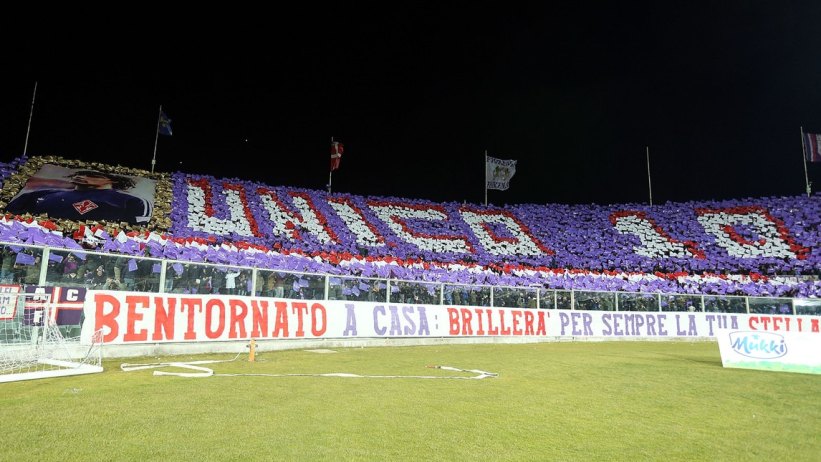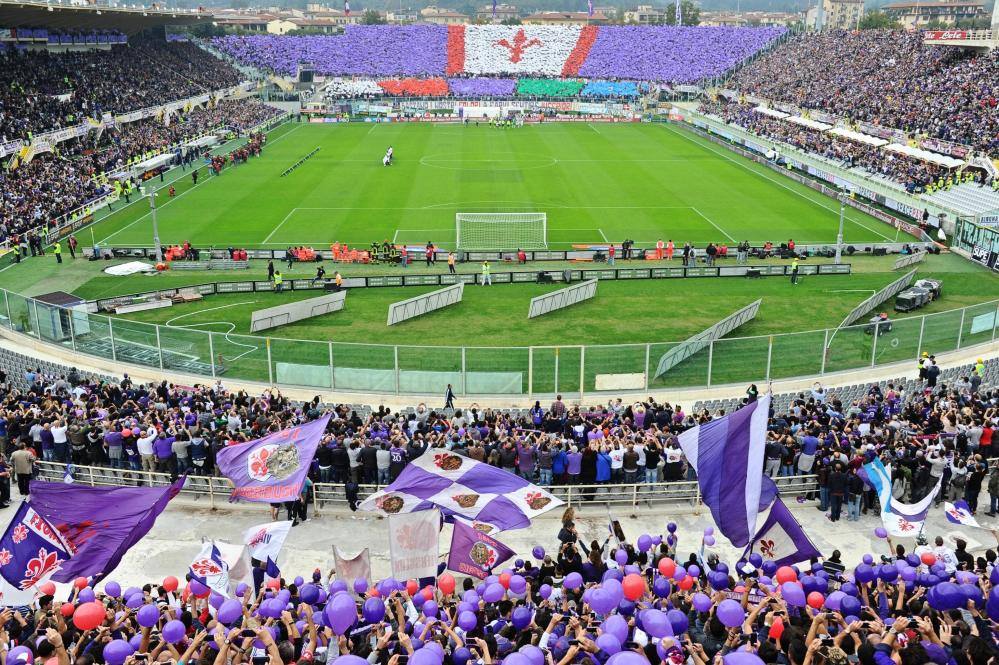Stadium: Stadio Artemio Franchi, capacity 47,290
Florence is one of the most beautiful cities in the world and is renowned for art and culture. It is therefore quite apt that it has a stadium that is one of the best examples of 20th century architecture in Italy.Designed by architect Pier Luigi Nervi, the stadium includes the huge, 230ft-tall “Tower of Marathon”. The concrete stadium has superb Roman-style pillars at the entrance and once inside there is a perfect view from whatever seat you are given.
The stadium was renovated for the 1990 World Cup, when the running track was removed and extra seating was added. The stadium feels like a purpose-built football arena and the large capacity creates a wonderful atmosphere. From the stands you can look out on to the truly breathtaking view of the rolling Tuscan hills.
The Ultras on the Fiesole stand are known as La Vecchia Guardia Firenze and are loud, well-organised and fiercely anti-Juventus. If you are going to watch football in Italy, this venue should be near the top of your wishlist. The derby against Bologna is also potent (I had fireworks thrown at me during the match in the stadium).
The Ultras

In 1289, a schism between the Pro-Papal Guelph forces of Florence and the imperial Ghibelline forces of Arezzo culminated in a brutal conflict at the Battle of Campaldino. This battle was part of the long struggle for power between the popes and Holy Roman Emperors in Italy. It also reflected the fervent civic rivalries of the era, rivalries that remain to this day. On the blood-strewn plains of Campaldino, the Florentines and their allies triumphed. It was a victory that secured the Guelphs in Florence.
The Tuscan Republic would go on to become the birthplace of the Renaissance, a civic colossus on the Italian peninsula. Florence remains a city of unquestionable prestige and, though the days of civic war are over, the city’s team, Fiorentina, provide an outlet for campanilismo – local patriotism.
Expressions of Guelphism are often seen at the Stadio Artemio Franchi and, under the aegis of the Ultras, the city’s medieval splendour lives on. The metropolis and its football club are viewed by supporters as one entity, so a victory for La Viola is a victory for Florence. The team is the city’s symbolic army and these cultural nuances set Fiorentina supporters apart in the world of Italian ultras.
Fiorentina are said to have the sixth largest following in Italy and this is exemplified in their numerous Ultra groups (I lost count at around 100). This perhaps reveals a trait particular to Florence: the need for individuality and ingenuity are entwined with the city’s glorious past.
The first origins of Viola fangroups can be traced back to 1965 and the formation of Vieussex (the name of a historic library in Florence) and Settebello (Beautiful Seven). These two groups are present today, with Vieussex residing in the Ferrovia stand and Settebello in the Fiesole, the heartbeat of the Artemio Franchi stadium.
One of the more renowned groups to have resided in the Curva Fiesole is theUltras Viola (Purple Ultras). Formed in 1973, a vicious fight with the Genovese led some fans to create a group of “super supporters” who could compete with any adversary. Founded and led by a man called Stefano “Pump” Biagini, this period is described by a Viola Ultra as the “glorious 1970s”, characterised by violent clashes, stolen banners, dangerous away days and above all the years of “Calcio vero” (uncorrupted football).
Despite the group’s prominence, the Ultras Viola disbanded just 10 years after their inception following violent exchanges with Romanisti which saw their twinning with the Romans come to an abrupt end. Stolen banners (which both fans blamed on each other) sparked an irreconcilable quarrel and this change, combined with a rise in eminence of Colletivo Autonomo Viola (CAV)(Autonomous Purple Collective), led to a changing of the guard. Created in 1978, CAV took a central position on the Curva and, despite their dissolution in 2011, the group’s vestiges have ensured that the Fiesole remains one of the most vivacious Curvas on the peninsula.
It is also worth highlighting the Alcool Campi (Alcohol Camp), a clan who lived a brief but fiery existence. This tempestuous group were said to be the culprits in an infamous incident, when Fiorentina Ultras launched petrol bombs on to a train full of Bologna fans. A 14-year-old died tragically and Alcool Campi quickly ceased to exist.
“Neither left nor right” has always been the motto of the Fiorentina Ultras, who have predominately refused political affiliation. This does not have any bearing on their twinnings and rivalries, epitomised in their longstanding friendship with Hellas Verona fans (traditionally right-wing) after ex-Fiorentina players joined the Gialloblu and helped them to their one and only Scudetto in 1985.
It is impossible to talk about Fiorentina without mentioning their virulent hatred for Juventus. When the Bianconeri come to the Artemio Franchi, a furore rages across the city. The origins of this rivalry date back to the 1981-82 Serie A season, when the Viola had the Scudetto snatched from their grasp by Juventus on account of some dubious refereeing. This rivalry was accentuated when Fiorentina cult hero Roberto Baggio was sold to Juventus in 1990, triggering riots across the city.
In parts of the Tuscan capital you can buy stickers that read “zona anti-gobbizzata” (“hunchback-free zone”). Hunchbacks are seen as lucky in Italy thus the nickname was patented for Juventus, a team seen as notoriously lucky. In what must be a sight to behold, albeit a strange one, Fiorentina fans have also been known to perform a ritual on players signed from Juventus in which they are “de-hunchbacked”.
The rivalry can take on a more sinister nature, with some Viola fans taunting their rivals about the Heysel tragedy which claimed the lives of 39 Juventini. Fiorentina fans have been known to wear Liverpool merchandise when facing their Turin adversaries, and following the tragedy in 1985, a banner was revealed by Fiorentina Ultras reading “39 less hunchbacks”. Juventus fans claim that this is why CAV attempted to befriend Liverpool fans back in 2009 when the clubs met in the Champions League.
Despite this, the Fiorentina Ultras are renowned for their loyalty, sarcasm and irony. They are no strangers to decrying the club’s hierarchy or the team itself if they feel things aren’t being done to their lofty Florentine standards. Former owner Vittorio Cecchi Gori, whose disastrous tenure at the club culminated in bankruptcy and demotion to Serie C2 in 2002, can certainly vouch for this. Viola fans had to endure the humiliation of losing the club name for a year – when they became Florentia Viola – and 30,000 of them descended on the city centre to make their feelings known to Cecchi Gori.
The hub of the Italian Renaissance, Florence is synonymous with Michelangelo, Dante, Machiavelli and the Medici. The Fiorentina Ultras take untrammelled pride in the city’s cultural history and the Artemio Franchi has become something of a holy ground for the Viola fanatics. Awash with purple and white, the stadium can produce electrifying atmospheres and decorative choreographies that even the greatest Florentine artists would be proud to call their own.
Classic Player: Gabriel Batistuta
Diego Maradona claimed that Gabriel Batistuta was the best striker that has ever graced the face of the earth. No greater praise can be heaped on the man known as “Batigol”, whose powerful play and deadly ability in the box made him feared throughout his career.Fiorentina have often had (and still have) fantastic offensive players but none have compared to Batistuta. In 1991, when he signed from Boca Juniors, nobody could have foreseen the impact he would have on Italian football.In nine years in Florence, Batistuta received almost religious adulation from theCurva Fiesole. This fervent worship of their new hero was created through his god-given ability to score goals. Serie A was in its pomp and known throughout the world for boasting some of the toughest defences of all time. Without exception, all of them feared Batigol like he was the devil himself.He is in the top 10 all-time leading goalscorers in Serie A history, having scored 168 goals in 269 games for Fiorentina and 184 goals in 318 matches in his time in Italy. He scored a goal every 1.7 matches.
Batistuta did not seek the limelight and was a loyal servant to the Viola. He stayed with the club when they were relegated to Serie B and helped them return to the top flight in the 1992-93 season. He turned down moves from bigger clubs, but unfortunately his loyalty was never rewarded with a Serie A title at Fiorentina.
When he eventually left the club, he walked away with a Serie B medal, a Coppa Italia winner’s medal and a Super Coppa Italiana trinket. The nearest he got to the title was in the 1998-99 season, when Fiorentina looked destined to win the title before Batigol pulled a hamstring and they missed out to Milan.
Roma eventually turned his head in 2000 and he left the Renaissance city and transferred his predatory instincts to the Eternal City. There he would also become a legend, helping Roma to win only their third title in a season that will go down in Giallorossi history. He scored 30 times in 63 games for Roma before being loaned to Inter.
He had everything: power, pace, skill, aerial ability, confidence and seemingly never-ending form. It is hard to think of another striker from this era who was more complete or deadly. When Calcio ruled the world, Maradona was watching and thinking “nobody is better than Batigol”.


